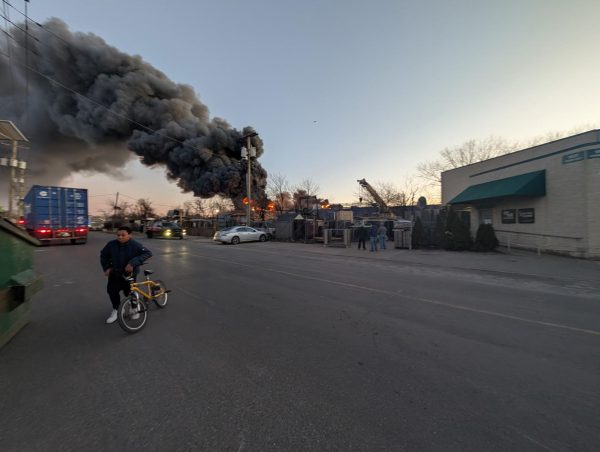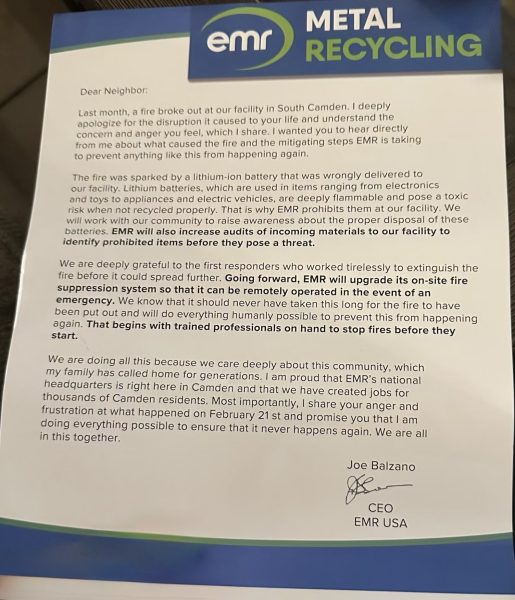
Abandoned row homes in the city of Camden filled with art. (Photo courtesy of Blake Bolinger)
Angielus Galarza is a 21-year-old nursing student who lived in Camden for seven years and has always had asthma. During her time in the city, she noticed that her symptoms were becoming more severe, which she suspected was due to the poor air quality.
“I am directly affected by the air pollution, as someone who’s asthmatic,” she said. “I believe it causes people like me to end up with breathing issues.”
Camden’s reputation has been known for its high poverty and crime rates, which have now taken a turn for the better. However, the excessive focus on issues such as these isn’t the only problem the town is experiencing. This small city in South Jersey, which directly faces the city of Philadelphia, has been exposed to climate change, which has intensified poor air quality.
“The effects of climate change on air quality will continue to vary by region,” according to a report by the Environmental Protection Agency. “In many areas of the United States, climate change is expected to worsen harmful ground-level ozone, increase people’s exposure to allergens like pollen, and contribute to worsening air quality.”

Since climate change has become a global phenomenon, it has caused many issues that vary on multiple levels and factors. A group that is directly affected by climate change and its risks is low-income communities.
Galarza, who currently resides in Florida, said her experience in a low-income community experiencing poor air quality has taught her that this issue should be more of a concern to the general public. Galarza believes more people who are asthmatic, like her, should care just as much as she does, since air pollution is a cause of intensified symptoms. Research has shown that one of the many leading causes of poor air quality may be industrial pollution of the type seen in Camden.
“Some of Camden’s environmental challenges result from past industrial pollution,” according to a report by the Delaware Valley Regional Planning Commission (DVRPC). “The city has nearly 200 known contaminated sites (including several Superfund sites). Of the city’s 21 neighborhoods, the Waterfront South community alone has 27 known contaminated sites and two Superfund sites.”
Camden was once a very popular industrial economy in the early 50s, according to the DVRPC. Its decline in population and economic distress created the downfall of industrial work, which is why it has many contaminated sites in neighborhoods today.
Dr. Marjorie Kaplan is a Senior Associate Director of Rutgers Climate and Energy Institute and co-director of the New Jersey Climate Change Resource Center, which helps inform individuals in New Jersey about climate change through research and technical guidance.
Kaplan has spent more than 30 years advocating for climate change and its effects on our world. She said she recognizes that climate change affects everyone, however, she believes the inequalities among low-income communities are intensifying, making them more vulnerable to effects such as poor air quality.
“In the past two years, we have all suffered from poor air quality due to massive wildfires in Canada and again in 2024 from several much smaller fires in our state and region that were fueled by a drought,” Kaplan said.
Among these fires are also the repetitive junkyard fires that happen directly in South Camden from companies such as EMR Metal Recycling, which has experienced a total of 6 fires with an average of one fire per year. The most recent fire occurred at the end of February.

Jonathan Compton, executive director of the Center for Environmental Transformation, mentioned how the fires have driven many residents out of their homes for several days due to the terrible air quality. The recycling company has often offered to pay for hotels for residents due to many low-income families being directly affected, making it harder for them to flee their homes when fires break out.
City residents recently received an apology letter from the company promising that another fire will not happen again. This, however, is not the only complaint residents of South Camden have mentioned about this recycling company.
“They have a giant metal shredder that shreds cars, and it puts, like, little pieces of metal and things into the air, and they also have a lot of dust that they create by driving their vehicles on these big dirt lots,” Compton said.
Compton mentioned that these extremes have brought residents to protest in front of the EMR company in South Camden, hoping that the company will be adequately regulated to prevent significant fires from happening once a year.
Another contributor to poor air quality and increased asthma symptoms is nitrogen dioxide, according to Dr. Elizabeth Cerceo of Cooper Medical School of Rowan University, where she is the director of climate health. With her deep connection to nature and the environment, Cerceo always knew she wanted to do more to help the environment, leading her to start working on climate advocacy and environmental health.
Although Cereco currently resides in Cherry Hill, just 10 minutes from Camden, she has worked with many organizations, such as CFET, and individuals as motivated as she is for environmental justice, such as Roy Jones, chief executive officer of the National Institute of Healthy Human Spaces, Inc. She has also spoken directly with residents and has noticed a rise in interest in environmental justice and how it has been causing a significant effect on residents’ health.
“Nitrogen dioxide associated with incidents of asthma is particularly concerning when we think about how it can convert into ozone in the presence of heat and sunlight,” Cerceo said. “It is also released in gas stoves.” Cerceo explained that nitrogen dioxide leaks even when gas stoves are not running. Although it is known as a natural gas, she says it is still not good for us and the environment.

“There have been a lot of studies that show that there’s increased respiratory conditions, particularly asthma, in kids who grow up in homes with natural gas stoves,” she said.
Cerceo said she believes change can be made through education. Teaching families better alternatives, such as electric stoves, to prevent such health risks can help bring about a change. Another strategy, she said, is teaching about climate change in low-income communities and the role it plays on children’s health in schools.
In addition, working with individuals who can make policies and build incentives, Cerceo says, can help create the transition needed to a clean energy future. That first starts with more hands on deck and more voices from residents of how it’s been directly affecting them. Cerceo recommends staying up to date with the state’s air report and also websites that are still providing information on climate change, such as the Yale Program on Climate Change, to help stay informed on the research and studies being conducted.
Despite the many negatives that the city has been experiencing due to the poor air quality, there have been successful progress made from organizations such as Camden For Clean Air. Camden for Clean Air was formed in May 2020 with a plan to stop Covanta’s trash incinerator, one of the largest air polluters in the city of Camden and all of Camden County, from being repurposed to help power a proposed microgrid. The organization’s goal became a reality in March of 2021.
According to the organization’s website, “VICTORY! After nine months of applying pressure, it was announced in early March 2021 that the microgrid would not be powered by the trash incinerator but by solar, digester gas, and batteries!”